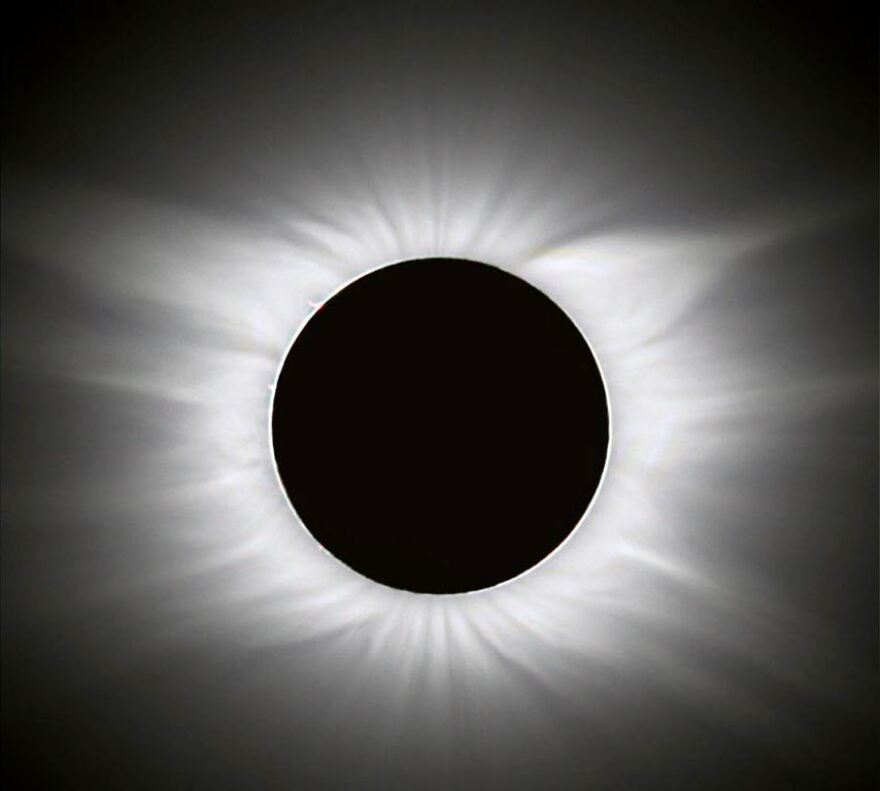Like any other day, the sun will rise on Monday. But close to noon in Missouri, the moon will start to cover the sun.
“You’re going to start to see little bits of the sun start to disappear, like someone slowly taking little bites out of a cookie,” said Anna Green, planetarium manager at the Saint Louis Science Center.
The sky will start to go dark quickly, like someone dimming the lights in a room. The air will also become colder, said Angela Speck, astrophysicist at the University of Missouri-Columbia.
“Outside the moon’s shadow, the temperature is still high,” Speck said, “so we get winds generated as air flows from high to low pressure, so you’ll get colder and more breezes.”
Researchers say there are anecdotes that suggest that animals may start acting like it’s nighttime. Birds may return to their nests and farm animals may go back into the barn. However, there isn’t a lot of research on how animals behave during total solar eclipses, since they’re rare and haven’t occurred very often over large areas of land. A 1999 study in Europe indicated, for example, that there was no change in the grazing behavior of cows when a total solar eclipse happened over parts of Europe.
Related reading: 6 things to know about the total solar eclipse, according to a science writer and eclipse chaser

Nicole Miller-Struttman, a biologist at Webster University who studies pollinators, thinks it’s possible that insects that forage during the day will stop looking for food.
“Once the eclipse hits, they actually go back to their nest, almost like they’re kind of conferring each other, wondering what’s going on,” she said. “I’m totally anthropomorphizing here, but it’s a strange event for them too.”
Near St. Louis, totality, or when the moon completely covers the sun, will occur at 1:16 p.m. A minute before totality, people might start to see odd lines forming on plain surfaces, called shadow bands.
“On the ground or any flat surface, you’ll see a series of light and dark bands and they’ll vibrate and move across the ground,” said Robert Pasken, a meteorology professor at Saint Louis University.
The shadow bands reappear approximately a minute after totality, too. Scientists don’t really know what causes them.
About 15 seconds before totality, a small sliver of the sun will be left peeking out the side of the moon,

looking like a diamond ring. Then, as the moon moves even more completely over the sun, something called Baily’s beads will appear. These are beads of light around the edges of the moon that are caused by sunlight shining through gaps in the moon’s mountains and valleys.
Related reading: 4 eye safety tips to know before the Aug. 21 total solar eclipse
Along the center of the path of totality, the total solar eclipse will last for about a couple minutes. It’s only during solar total eclipses that people can see the corona, the outer atmosphere of the sun.
“[The corona] looks like streamers of gas flowing away from what looks like a hole where the moon is blocking out the sun,” Speck said.
The corona will light up the sky as much as a bright full moon night, she added. Venus will be the brightest object in the sky. Observers will also see Jupiter, Mars, Mercury and the constellation Leo, which is usually obscured by the sun in August, along with the stars Sirius and Regulus.
It’s only during the very brief period of totality that people can remove their solar filters or look up from their pinhole projectors to look directly at the eclipse.
“Don’t forget to experience it,” Green said. “Even though I’m excited to take pictures and have that record

to bring back to everyone, I also plan to force myself to take a moment and soak it all in. We are so used to living our lives through Snapchat, Facebook and sharing all those experiences through social media that sometimes we forget to experience it for ourselves.”
The next total solar eclipse that will be visible in the St. Louis area will take place in 2505.
On Monday, some will venture out to places within the path of totality where the eclipse can be seen the longest, such as the Missouri towns of St. Clair and De Soto, and Hawk Arrow Springs, which is hosting the Darkening of the Sun festival. Here are some suggestions on what eclipse chasers may want to pack on the day of the event:

Follow Eli on Twitter: @StoriesByEli
Inform our coverage
This report was prepared with help from our Public Insight Network. Click here to learn about how you can be a part of our conversations. Click here to see more insight from PIN sources.





